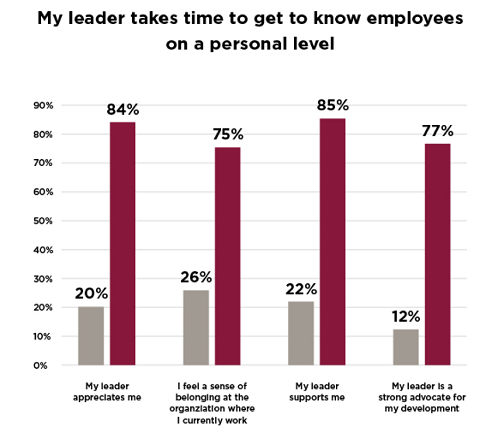
Fancy perks may not guarantee a thriving workforce – but doing this might
.jpg)
The new year has arrived, and perhaps you don’t have the budget or resources to implement fancy new perks to improve your workplace culture. This might be the year to start making changes to your culture from the inside out, by making simple changes in how you interact and connect with your people.
We found six powerful ways you can begin building a workplace culture where employees thrive:
1. Provide opportunities for connection
When employees feel connected to their organisation, their accomplishments and their peers, they thrive in the workplace.
Set aside time for employees to network and connect with one another, on company time. By simply providing mentorship opportunities to employees, companies find their employees are 66% more positive about career advancement at the organisation, 30% more likely to believe they influence important decisions at work, and 56% more likely to say they are learning new things at work.
Promote positive interactions and diversity in work relationships to build a sense of belonging. Frequently communicate to employees how their work aligns with the purpose, strategy and goals of your organisation.
And celebrate employee successes – whether it’s extra effort, great work or personal or career milestones – to help employees feel they are making a difference at work.
2. Be inclusive beyond diversity
Inclusiveness is more than just diversity. It’s not just a policy, it means making sure employees feel they can bring their best and most authentic selves to work. It’s feeling like you belong, regardless of your race, gender, age or background.
By creating positive interactions and experiences for all employees, organisations can help their people build deeper social ties with their co-workers and leaders. When an organisation has an inclusive culture, employees are 141% more likely to feel a sense of belonging, and 117% more likely to feel enriched by the people they work with.
3. Clearly connect the dots between your employees’ work and your organisation’s purpose
Employees need to see the importance of their work. Having frequent conversations about what someone is specifically doing to contribute to the purpose of the organisation shows how they are adding value and making a difference in the world.
Research shows when employees feel they are doing meaningful work, there is a 42% increase in the feeling their leader supports them, 52% increase in feeling successful, a 61 point increase in employee Net Promoter Score, and a 49% increase in feeling highly motivated.

4. Make employee recognition a priority by changing when it occurs
Recognition cannot be an afterthought. It must be a priority for every organisation. Even if you can’t increase your recognition budget or implement new tools, change when you give recognition.
Make sure it takes place at the beginning of a meeting, at the top of the agenda, in the first section in the newsletter. Or have an entire short meeting dedicated to only giving recognition. When recognition is left to the end, it is almost always rushed, forgotten, or not done in a meaningful way.
When recognition is not seen as a priority for the organisation, employees are 70% less likely to feel appreciated, 74% less likely to stay at the organisation, 42% less likely to be engaged, and 46% less likely to promote their organisation.
5. Allow for safe failure
The most innovative and successful companies have a company culture where failure is allowed. By allowing, acknowledging, and learning from failure, employees are more likely to continue to be innovative.
When failure is accepted as part of the innovation process, 60% more great work and 166% more innovation happens. 78% of employees are committed to staying with their companies when their company encourages creativity and innovation, and there is a 133% increased chance that the company’s revenue has increased.
The key to safe failure is to fail and learn from failure together. Failing and succeeding at something together than build stronger bonds than any team-building activity. Recognise the risk taken when responsible failure occurs and move on together.
6. Encourage leaders to really know their people
Leaders must be more than bosses, they should be mentors and advocates for their people. There is a drastic difference in the employee experience when employees feel their leaders know them on a personal level.
Leaders should know their strengths and weaknesses at work, but also their dreams and goals. Where do they want to be in their careers? What do they like to do outside of work? How they like to be managed and appreciated? How is their well-being: physical, social, and emotional? What are the key milestones in their personal lives? Who do they connect with at work?
When leaders get to know their employees personally, employees feel more supported, appreciated, and connected.
For more powerful ways to improve your workplace culture, check out O.C. Tanner’s 2018 Global Culture Report and see how you can build a workplace where employees thrive.
The article originally appeared on O.C. Tanner